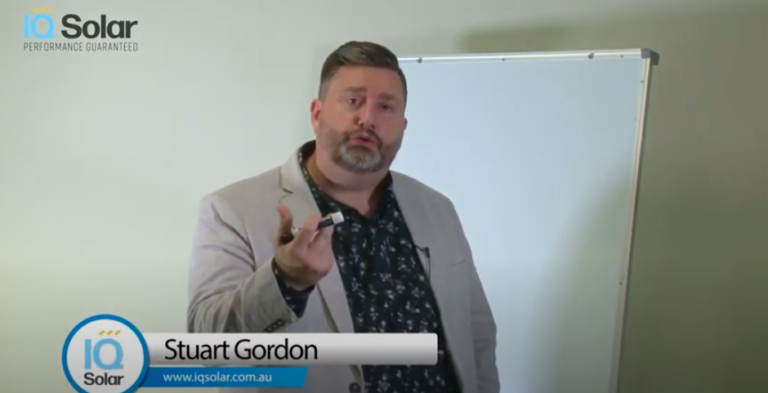What an inverter does and types of inverter

What are inverters?
I want to discuss inverters and what they do, and three choices that we’ve got when we’re talking about inverters with a solar system. So just to simplify, basically what is happening with a solar system is that you have panels. These produce DC electricity. These run to an inverter which converts from DC to AC current. AC is what we use inside our houses, and then that goes into your supply. So there’s three types or three scenarios. One is what we call a string inverter. The second is called string-optimized, and the third is what’s called a micro-inverter. So with a string inverter, let’s say we were looking at a reasonable-size system, 10 kilowatts or thereabouts, it might have an inverter. There are two inputs into this, which are called MPPTs, and with each, you can have two independent strings. There are actually more ways to do this if you have multiple strings and so forth, but just to keep it simple, two independent strings.
Power flows is cabled up and flows along here into this particular MPPT. If you’ve got something that happens, so shading or bird poop, and shading’s the biggest one. It can be from trees or it can be from antennas or overhead wires or whatever, but shade kills solar. It’s the natural enemy. So basically, if you’ve got something that impacts a couple of panels, they actually set the bar for what is flowing through the system. It’s like stepping on a hose pipe. It reduces the flow all the way along. So this is one of the constraints of a string inverter system. They make sense when you’ve got a nice clear roof, no shading, but there’s other factors like even bird poop will cause this to be sub-optimal. The next option is what I call optimizers. There’s two systems that are popular. One is called SolarEdge, and there’s another called Tigo. So what these do, it’s an electrical device on the back of each panel, which means that these panels become somewhat electrically independent of each other. Anything that’s affecting this one shouldn’t affect this one.
They still have some of the same constraints for system design in terms of string lengths and minimum inputs into these channels, for example, but they really do an amazing job of optimizing each panel. Some of them have other benefits. SolarEdge for example has incredible monitoring of the system well above what almost any string inverter will have. The third option is called a micro-inverter, which actually converts from DC to AC at the panel level. So the back of each panel is a micro-inverter. This is one. There’s only one company that makes these called Enphase. There’s been another company, but Enphase bought them. So these are basically the crème de la crème of how to put together a solar system. Every panel is individually optimized. You will typically get a higher output of any system of 15% or more compared to a string or an optimized system. They are more expensive, but it will pay for itself over time.
So this is quite an amazing unit. There are zero moving parts in this. It has a 20-plus year life span. It has a 10-year warranty. And once they’re made, they’re actually filled with epoxy or polymer, so they’re really quite dense and heavy. They have incredible temperature resistance and so forth. So I really like micro-inverters, and I think that for people who are looking for a premium system, it’s a really great way to go. You’re going to get the best that is possible. The monitoring that comes off these is also of very good quality, and you can choose a base-level of system monitoring or a panel-by-panel monitoring. So panel-by-panel monitoring is for the super geeky, but you can actually see what every panel is doing at any given time. If you were looking at putting batteries on later, and I’ll discuss monitoring separately, but not just monitoring what the system is doing, but also your household consumption. So straight out of the box, you get that with Enphase.
So there’s an app, and you can see it on your computer. The app is called Enlighten, and it will let you see both your household consumption as well as the solar production. So you can look at that, we can look at that over time and figure out whether or not batteries are going to be viable for you. Anyway, those are the three options, string inverters, optimized string inverters and micro-inverters. So when we’re talking about equipment, we’ll probably suggest one of these different sets of technology for your place, and of course, we’re always happy to talk about what you might have seen or been offered separately in the market. So that’s a common occurrence that you would have been offered something. And you’ll say, “Hey, someone has suggested SolarEdge. Is that good for me?” And we can help you figure out whether or not that is the right choice.
Recent Videos:
What is NOT buying solar costing you?
Reasons not to choose the cheapest solar systems
Mistakes people make when buying solar systems in Sydney
The trap of "interest free" money in solar power
10 facts about the STC solar 'rebate'
Why do people offer 6.6kW solar systems?
What is the solar rebate change from 2020 to 2021?
Why people promote 6.6kW systems?
What happens to a solar in a blackout?
What angle should solar panels be at?
To tilt or not to tilt solar panels?
Optimizing vs Maximizing system sizes
Made in China - is that an issue?
What an inverter does and types of inverter
How we analyse commercial solar?
How much of my power bill I can eliminate?
Do batteries make sense for your solar system?
What solar panels should you choose?
What angle is best for solar panels?
